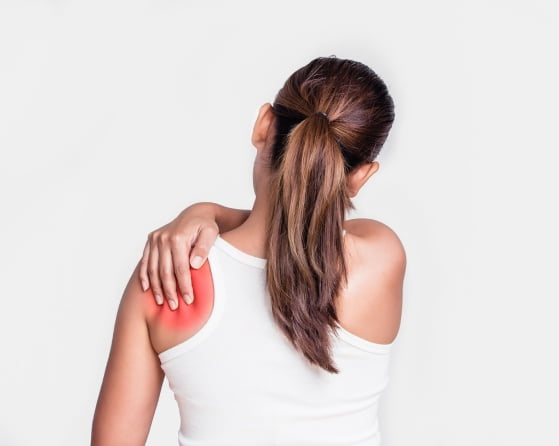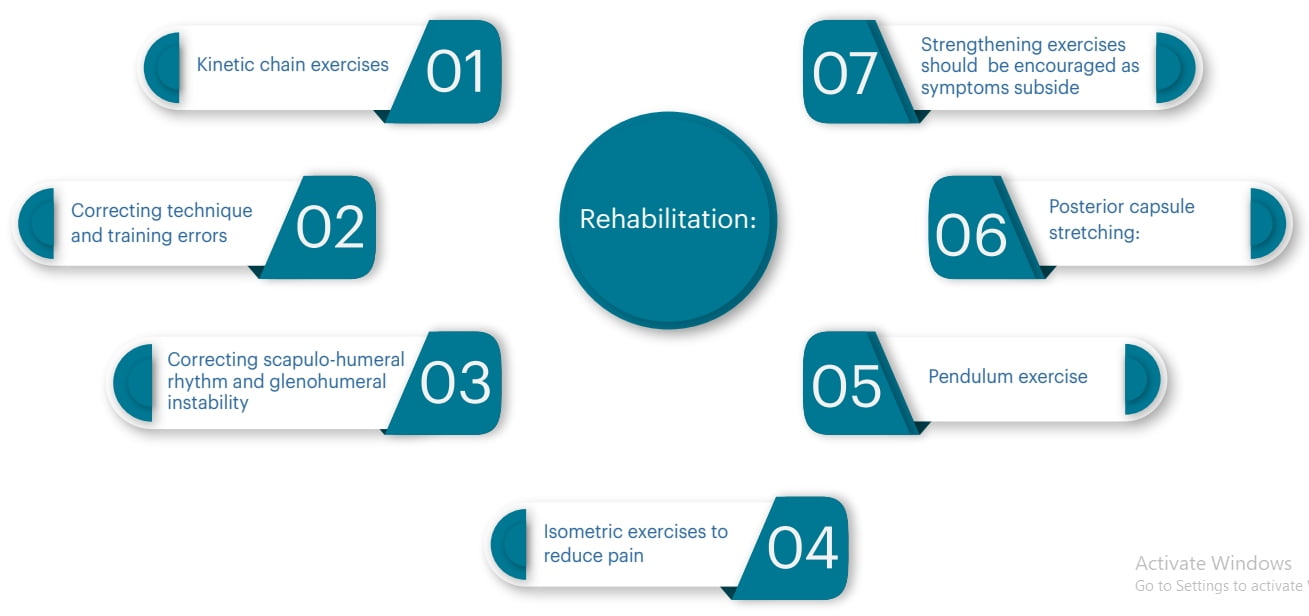
Rotator Cuff Tendonitis
Rotator cuff tendonitis involves the tendons of the muscles forming the rotator cuff of the shoulder. As these muscles govern the movements of the shoulder joint, rotator cuff tendonitis is a very common cause of shoulder pain and weakness. Also referred to as impingement syndrome, some common daily activities like sleeping on one’s shoulder and engagement in daily overhead work can predispose individuals to rotator cuff tendonitis. Athletes involved in sports requiring overhead movements such as tennis, baseball are commonly involved. Hence this condition is also referred to as Swimmer’s shoulder and Pitcher’s shoulder.
Rotator Cuff Tendinopathy is an umbrella term encompassing the following conditions: “tendinitis, tendinosis, paratendinosis or partial tears of the Rotator Cuff tendons.
CLINICALLY RELEVANT ANATOMY
The muscles arise from the scapula and connect to the head of the humours, forming a cuff at the glenohumeral joint
- Viral Infections such as Varicella Zoster Infection which is known to cause Chickenpox and Shingles, can result in post viral intercostal neuralgia.
- Trauma to the chest wall or fracture of one or more ribs can be responsible.
- Entrapment of the Intercostal nerve by a tumor of the chest or abdomen. Has been associated with benign tumors as well.
- Iatrogenic- Surgeries which involve opening of the chest to access throat, lungs, heart or diaphragm, can result in Intercostal nerve injury as a surgical complication.
- Neuritis of the Intercostal Nerves- Neuritis, which refers to inflammation of a nerve or a group of nerves can cause Intercostal Neuralgia. The cause of neuritis may be bacterial, viral or immune modulated.
- Muscle pull or strain in the shoulders, chest wall or back can also be the cause.
- Idiopathic- when no clear cut cause is discernible.
EPIDEMIOLOGY
Tendinopathy of the rotator cuff seen in as many as 30% of individuals at some time in their life and is the most common cause of shoulder pain worldwide. Sports and Occupational activities like painting and carpentry demanding repetitive daily overhead activities ,especially predispose individuals to rotator cuff tendonitis. The following conditions can be grouped under the term Rotator Cuff Tendinopathy: tendinitis, tendinosis, paratendinosis or partial tears of the Rotator Cuff tendons
RISK FACTORS
These might be classified as Occupational and Generalised
Occupational Risk Factors
- Work requiring long hours of static and uncomfortable postures.
- Working with heavy machinery
- Direct Load Bearing
- Repetitive Arm Movements interspersed with minimal or no rest.
- Working with hands above shoulder height
- Certain Sports (Repetitive Arm Motion)
Generalised Risk Factors
- Muscle Imbalance
- Metabolic Disorders: Non-familial Hypercholesterolaemia, Diabetes, Adiposity.
- Decreased Flexibility
- Obesity
- Advancing Age
SYMPTOMS
- Patients usually present with aching in the area below the deltoid and this pain is aggravated by movements such as abduction, elevation and sustained overhead activity.
- The pain might be located in the front and top of the shoulder or may radiate down to the lateral upper arm.
- Pain can be triggered by raising or lowering of arm.
- Some patient may experience a clicking sound when raising your arm.
- Shoulder stiffness
- Shoulder pain can sometimes disturb sleep as well
- Pain when reaching behind your back
- A loss of mobility and strength in the affected arm
CLINICAL SIGNS
Empty Can’s Test and Hawkin’s impingement test are clinical tests which give a suspicion of rotator cuff tendonitis.
DIAGNOSIS
High Definition Diagnostic ultrasound in a skilled clinician’s hand is considered the imaging tool of choice when it comes to diagnosing Rotator Cuff Tendinopathies [1] partial thickness tears, thickened subacromial bursa and rule out a full thickness tear[6] MRI-scans are also used to diagnose Rotator Cuff tendinopathies and partial rotator cuff tears.
DIFFERENTIAL DIAGNOSIS
- Adhesive Capsulitis
- Biceps Rupture
- Bicipital Tendinopathy
- Cervical Disc Disease
- Cervical Sprain & Strain
- Complex Regional Pain
- Osteoarthritis
- Rheumatoid Arthritis
- Shoulder Pain in Hemiple
- Thoracic Outlet Syndrome
TREATMENT
Non steroidal anti inflammatory medications like ibuprofen and etodolac along with rest from exertion are tried initially. Patients not responding are often subjected to physical therapy which is focussed on shoulder strengthening and range of movement exercises.

INJECTIONS
Corticosteroid injections have been used for their potent anti inflammatory action but repetitive injections can cause damage to the tendon.
SURGERY
If an MRI shows a complete rotator cuff tear, surgical repair usually under arthroscopic guidance may be required. Surgery for recurrent rotator cuff tendonitis (bursitis) is occasionally performed to:
- Remove a prominence or spur on the under surface of the acromion.
- Remove chronically inflamed, thickened and fibrotic bursal tissue.
- Inspect the tendons and tidy up and sometimes repair a tear in the tendons.









Leave a reply